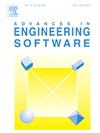Advanced numerical modeling for nonlinear responses of sandwich multiphase composite plates with viscoelastic damping core
IF 5.7
2区 工程技术
Q2 COMPUTER SCIENCE, INTERDISCIPLINARY APPLICATIONS
引用次数: 0
Abstract
This study introduces an advanced numerical model for the nonlinear dynamic analysis of sandwich multiphase composite plates composed of carbon nanotubes (CNT), carbon fibers, and epoxy, featuring a viscoelastic core modeled using the Golla–Hughes–McTavish (GHM) method. The proposed framework uniquely combines the Cell-Based Smoothed Discrete Shear Gap Method (CS-DSG3) with the sinusoidal–zigzag shear deformation theory, pioneering their integration to improve layerwise modeling and viscoelastic damping analysis. The sinusoidal–zigzag theory effectively captures the continuous in-plane displacement distributions, yielding superior predictions of the layered structure’s mechanical response compared to classical theories. By incorporating the von Kármán displacement–strain relationship, the model effectively captures the passive damped dynamic behavior of viscoelastic core plate under large deformations. The Newmark time integration scheme and Picard’s methods are employed to efficiently solve the resulting nonlinear equations of motion at each time step. Validation against benchmark studies demonstrates the model’s accuracy and reliability in capturing the complex dynamic responses of laminated systems. A comprehensive parametric investigation further explores the impact of material properties, including the volume fractions and configurations of CNTs and carbon fibers, on the nonlinear dynamic behavior. These advancements position the model as a computationally efficient and high-fidelity tool for analyzing the nonlinear dynamics of complex laminated composite structures.
粘弹性阻尼芯夹层多相复合材料板非线性响应的先进数值模拟
本文引入了一种先进的数值模型,用于碳纳米管(CNT)、碳纤维和环氧树脂组成的夹层多相复合材料板的非线性动力学分析,该模型采用了Golla-Hughes-McTavish (GHM)方法建模。提出的框架独特地将基于单元的平滑离散剪切间隙方法(CS-DSG3)与正弦之字形剪切变形理论相结合,开创了它们的集成,以改进分层建模和粘弹性阻尼分析。与经典理论相比,正弦之字形理论有效地捕获了连续的平面内位移分布,对层状结构的力学响应做出了更好的预测。该模型通过引入von Kármán位移-应变关系,有效地捕捉了粘弹性芯板在大变形下的被动阻尼动力行为。采用Newmark时间积分格式和Picard方法有效地求解每个时间步长的非线性运动方程。对基准研究的验证表明,该模型在捕获层压系统的复杂动态响应方面具有准确性和可靠性。全面的参数研究进一步探讨了材料性能,包括碳纳米管和碳纤维的体积分数和结构,对非线性动态行为的影响。这些进步使该模型成为一种计算效率高、保真度高的工具,用于分析复杂层压复合材料结构的非线性动力学。
本文章由计算机程序翻译,如有差异,请以英文原文为准。
求助全文
约1分钟内获得全文
求助全文
来源期刊

Advances in Engineering Software
工程技术-计算机:跨学科应用
CiteScore
7.70
自引率
4.20%
发文量
169
审稿时长
37 days
期刊介绍:
The objective of this journal is to communicate recent and projected advances in computer-based engineering techniques. The fields covered include mechanical, aerospace, civil and environmental engineering, with an emphasis on research and development leading to practical problem-solving.
The scope of the journal includes:
• Innovative computational strategies and numerical algorithms for large-scale engineering problems
• Analysis and simulation techniques and systems
• Model and mesh generation
• Control of the accuracy, stability and efficiency of computational process
• Exploitation of new computing environments (eg distributed hetergeneous and collaborative computing)
• Advanced visualization techniques, virtual environments and prototyping
• Applications of AI, knowledge-based systems, computational intelligence, including fuzzy logic, neural networks and evolutionary computations
• Application of object-oriented technology to engineering problems
• Intelligent human computer interfaces
• Design automation, multidisciplinary design and optimization
• CAD, CAE and integrated process and product development systems
• Quality and reliability.
 求助内容:
求助内容: 应助结果提醒方式:
应助结果提醒方式:


